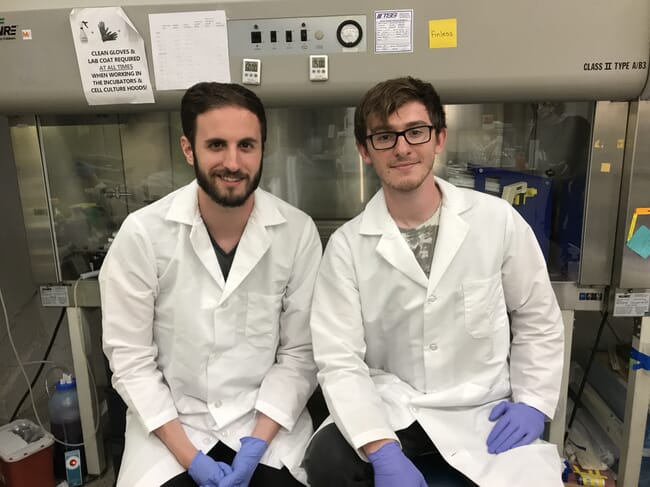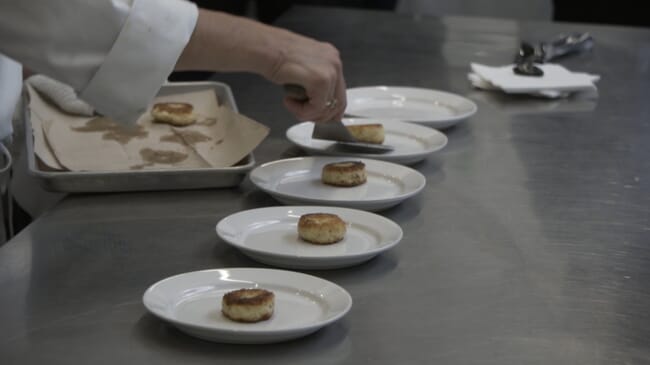Cell-based fish: background to the business
Currently, there are less than 10 cell-based seafood companies in the world. Companies like Finless Foods grow edible fish in a food certified facility from small biopsies of fish cells. Though it sounds like something out of science fiction, the companies have each raised millions of dollars from investors in their first round of funding.
There are multiple reasons why cell-based fish could be successful and sustainable: culturing the cells on land reduces the economic and environmental pressures on fisheries. It presents a new approach to species conservation. Cell-based seafood doesn’t harm the donor fish, so bioethicists and welfare activists from PETA are comfortable claiming that it’s cruelty-free. Since the fish is grown in lab-controlled conditions, the environmental pollutants associated with industrial fishing and traditional aquaculture aren’t present in the finished product.

© Finless Foods
What was your motivation for creating Finless Foods?
I went to an agricultural school, studying biochemistry and molecular biology. I’ve always been interested in the food system and how it relates to social and economic justice and food justice. I’ve done a lot of political activism in my life, and we were seeing that the ocean is under greater strain and is on the brink of collapse. We just thought that we don’t have a lot of time left, and if we don’t reverse how the world eats and creates its power, we’re going to have irreversible climate collapse within the next 12 years.
A lot of it was sustainability as well. In 2014 I read an article called “The last days of the blue-blood harvest” in The Atlantic, how we harvest horseshoe crabs for their blood in order to use it in pharmaceuticals, and people realised that we were destroying horseshoe crab habitats, and we couldn’t catch them at a fast enough rate to sustain production. So scientists set out to make an equivalent. Something that could be made outside of a horseshoe crab but would serve the same function. And in reading this article, I thought that if we could do this with horseshoe crab blood, why can’t we do that with any meat at all? And going to school for agriculture, I saw how animal agriculture was a massive blight on the planet. And I started Googling around to see if someone had tried this, and it turned out that I was not totally crazy. I ended up moving to New York and working at New Harvest. It’s an organisation that takes donations and puts them towards PhD projects in this field. But in working there, I met a lot of other investors. I dropped the grant, and I took the investment money and did this instead.
It just feels like a better allocation of resources and is more in line with my skill set. I’ve always been on the side of science communication rather than doing lab work itself. I pulled in my friend Brian from college, and we started by designing a tech work flow, we applied to IndieBio, which is a life-science accelerator in San Francisco that had a lab that we wanted. From there we made our first prototype, which was the first cell-based seafood of its kind to be eaten by anybody, and the first cell-based meat or seafood that was eaten by journalists, and not just by a friend of the company. And so with that we were able to raise a whole bunch of money and hire some people so now we have our own lab and have 11 full-time people.
Of all the cellular agriculture possibilities, why fish?
Nobody was working on this problem in the fish space – people were already doing cellular agriculture for meat-based stuff, but nobody had yet tried fish. So I felt like it was not only something I was attached to personally, but also something that needed work done.
How did you land on bluefin tuna in particular?
So, with bluefin tuna, we’re taking [tissue engineering] technology and making it cheaper until it can hit food-grade prices. And so, halfway between those two prices is luxury goods. Bluefin tuna is one of the most expensive varieties of meat so it seemed like an easy thing for us to shoot for at first. For us, it’s the same cost to make tilapia as it is to make bluefin tuna, so we might as well start at the top and go down from there. On top of that, it’s a threatened species, and fishing it is really destroying the ocean. And we’re filling a market need. There currently aren’t any ways to scale up bluefin tuna aquaculture.
What were the unexpected challenges that you had to overcome?
There have been a bunch! So we knew that when we dove into this that we were doing something unexplored. There are a lot of companies on the meat-based side of things, whereas for seafood, there are four. And most of that is related to the fact that so little research has been done in seafood cell culture. We’re starting from scratch in a lot of ways. We felt that we anticipated that problem, but the magnitude of it was something that we didn’t feel correctly going into it. There’s been a lot of moving in low information environments. On the other hand we have found that fish cells are easier to work with in a lot of ways. It seems easier to make them spontaneously immortalise, or self-immortalise [a process where the cells continue to divide and proliferate when they normally wouldn’t], and also, we feel that the structure is a bit simpler. If you look at something like a steak from a cow, you have this complex swirling of marble and fat, whereas if you look at something like a salmon, you have layers of muscle-fat-muscle-fat, and that makes it easier for people to print that using current tissue engineering techniques. On top of that, the fact that the price point is higher means that we can pursue much more established technology, driving costs down. In California, in restaurants, the cheapest [bluefin tuna] you can get to the end consumer is about $150 per pound, which ends up being like $7 for a piece of sushi meat. So it makes things easier for us in a lot of ways, even though there are ways in which it’s difficult.

© Finless Foods
When do you expect to reach commercialisation?
Soon-ish. We are bringing it to market as fast as we can. We’ve been withdrawing timelines publicly because we’re just like, “it’s going to be ready when it’s ready.” We just want to make sure that when it first hits the market, it’s extremely delicious and is very presentable. Whatever you come out with first, people are going to remember, especially in terms of food. So we just want to make sure that it’s great before it gets there. But we also need to make sure that it’s safe. [We also will be] working with regulators to ensure safety. And that stuff is also hard to put a timeline on.
It seems like the biggest barrier to commercialisation is the cost of the growth medium. How have you tackled that issue?
There are a bunch of different levers that can be pushed in order to bring down price. The three main ones are the costs of the inputs – just like fish farming, we need to create a cheaper feed. There’s the efficiencies of the cells themselves, so this is: “How many cells can be grown per litre of media?” This is something that will be based on the ingredients in our media, but also based on breeding our cells together and selecting the cells that work more efficiently – in a similar way to how crops are bred. And then the third would be recycling of the growth media. So, really, all three are related to the costs of the inputs, but that’s how farming works in general.
Is your serum plant-based?
We don’t intend to take to market any sort of media that involves animal components. It defeats the point of the company to use [animal-based serum]. We got into this for environmental reasons, and we think that involving animal-based ingredients in the feed itself is a little defeating for us.
Have you had to overcome any regulatory hurdles?
To say that we have overcome them would be like saying that we’re further along than we are. [In the US] it seems like cell-based seafood is going to be regulated by the FDA. We’re going to have to go through pre-market approval… We think this is an important part of our process because we want to make sure people trust what we do. We think that the regulatory system is a really good way to gain public trust on that. One of the regulatory hurdles that we’ve been really pushing for is labelling. We had the US Cattlemen’s Association say that we’re not allowed to call cell-based beef “beef”; it has to be called something else. I made an argument in front of the FDA that we definitely need to call this what it is. If you’re allergic to seafood, you’re definitely going to be allergic to what we make. And so, to not call it what it is would create a public health hazard.
Do you think that you’ll ever reach price parity with conventional tuna?
I do. I don’t think that will come soon. I think at first this will be a luxury good; I think it will be something that’s fairly expensive. I think we can definitely hit bluefin tuna prices. For other varieties of tuna, that’s our hope. It’s technically feasible to produce food this way – in part, because we just don’t have as many inefficiencies in our system. Fish have to spend a lot of energy being a fish and keeping the body of the fish alive, whereas we’re trying to create this extraordinarily waste-less process, where all energy gets devoted into the creation of meat. I do believe that this process will be cheaper than everything, but it could take a bit of time.




